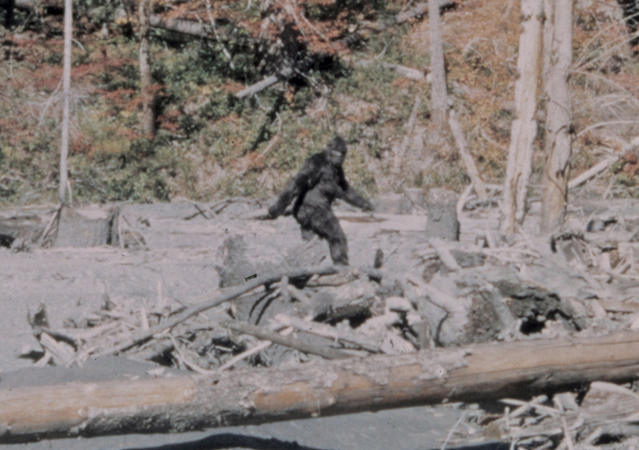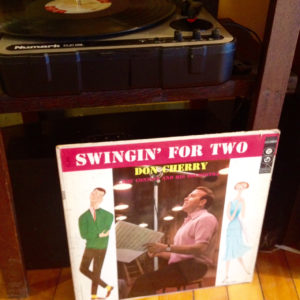Just in time for the weekend, here’s a little list of some of the things I’ve been listening to and reading this week, some of it online — Storyboard included, natch — and some of it on vinyl or actual ink and paper.
Two of my biggest loves are narrative journalism and music, and I’m lucky that my days are filled with both. When reading stories, I get inspired by songs I think fit the article’s theme — a soundtrack. Here are a couple of this week’s Storyboard articles, and their soundtracks:

A frame grab from the famous film.
Annotation Tuesday! Leah Sottile and “The Man Who Created Bigfoot.” I really like Leah Sottile’s thoughts on journalists and covering things outside the mainstream. She comes from an alt-weekly background and has been part of the Portland (Oregon) punk scene, so she’s no MSM journo. And she likes it that way: “Some people I know can’t deal with associating with people whose views are different from theirs. And I think it sort of sucks that people don’t use journalism to understand the full range of perspectives out there,” she says. “When it comes down to it, I can talk to people whose views fall outside the mainstream because my own views absolutely fall outside the mainstream. I’ve never wanted to be a part of the mainstream — which I think is pretty obvious to most people who meet me, and that makes them more comfortable talking to me than they might be to a tie-wearing, press-pass-flashing reporter.”
The Soundtrack: “Bigfoot,” by Cayucas. This band can be such fun, like summertime on a record. (Example: Cayucos, which for some reason is spelled correctly, like the California town, unlike the name of the band itself. Some sort of trademark issue?) This one plods along. I’ll be generous and say it’s deliberately matching the plodding gait of the creature in question.
5(ish) Questions: Charlotte Magazine and the shooting of Keith Scott. I kind of have a theme going in this week’s column: the liberal media elite (of which I have been a member). Leah Sottile, above, talks about working outside that journalism mainstream, and Sarah Smarsh, below, writes about the implications of political coverage from a privileged point of view. In this piece about a small-staffed magazine’s decision to cover the unrest in the wake of the police shooting of a black man, I pointed out that most journalists don’t work at The New York Times or The New Yorker or in newsrooms with several hundred people. Most work for small-city dailies or TV stations. Or small-town and alternative weeklies. Or magazines with a full-time staff in the single digits. And doing cool work that often goes under the journalism radar.
The Soundtrack: “Riot Van,” by Arctic Monkeys. I think Alex Turner is one of the most gifted British songwriters of his generation. He’s a brilliant wordsmith, kind of the Elvis Costello of the Millennial set.

A festival-goer experiences virtual reality at the Future of Storytelling gathering.
Dying along with Whitney Houston at the Future of Storytelling Festival. Virtual reality is an amazing new(ish) addition to the big tent that is storytelling. But I admit feeling a bit queasy about one of the exhibits at a virtual-reality festival in New York last weekend: “dying” along with a famous person. Jasmine Bager described the experience, which involved the smells and sounds of Whitney Houston’s last moments: “I felt a moment of pure dread when it all suddenly went silent and I couldn’t smell anything. I contemplated pressing the panic button they placed at my chest, when they opened up the door and brought me back to the light. My thought as I was wheeling out was, ‘She must have been so lonely during her last moments.’” That humanizing, empathetic moment elevated the experience above the purely voyeuristic. (But it still gives me pause.)
The Soundtrack: “Virtual Insanity,” by Jamiroquai. Yes, his white Stevie Wonder shtick does get a bit old if you listen to an entire album. But in small doses, Jamiroquai is pretty irresistible. And I loved the video for this one.
What I’m reading online: “Dangerous Idiots: How the liberal media elite failed working-class Americans,” by Sarah Smarsh. This Guardian piece is a pretty damning indictment of college-educated liberal journalists and their (our?) failure to understand the white working class. There’s this:
“The faces journalists do train the cameras on – hateful ones screaming sexist vitriol next to Confederate flags – must receive coverage but do not speak for the communities I know well. That the media industry ignored my home for so long left a vacuum of understanding in which the first glimpse of an economically downtrodden white is presumed to represent the whole.”
And this:
“I’m hard-pressed to think of a worse slight than the media figures who have disregarded the embattled white working class for decades now beseeching the country to have sympathy for them. We don’t need their analysis, and we sure don’t need their tears. What we need is to have our stories told, preferably by someone who can walk into a factory without his own guilt fogging his glasses.”
And, finally, this:
“If you would stereotype a group of people by presuming to guess their politics or deeming them inferior to yourself – say, the ones who worked third shift on a Boeing floor while others flew to Mexico during spring break; the ones who mopped a McDonald’s bathroom while others argued about the minimum wage on Twitter; the ones who cleaned out their lockers at a defunct Pabst factory while others drank craft beer at trendy bars; the ones who came back from the Middle East in caskets while others wrote op-eds about foreign policy – then consider that you might have more in common with Trump than you would like to admit.”
 What’s on my bedside table: “Ranging the Maine Coast,” by Alfred F. Loomis, with illustrations by Edward A. Wilson (because the illustrations really make the book). Some friends were in town this week and went on a sail on one of the last days of the sailing season, so I picked up this book again, just to keep that summer vibe going. It’s an account of sailing up the Maine coast in 1939 in a cruiser named the Hotspur. Here’s one bit I love to reread:
What’s on my bedside table: “Ranging the Maine Coast,” by Alfred F. Loomis, with illustrations by Edward A. Wilson (because the illustrations really make the book). Some friends were in town this week and went on a sail on one of the last days of the sailing season, so I picked up this book again, just to keep that summer vibe going. It’s an account of sailing up the Maine coast in 1939 in a cruiser named the Hotspur. Here’s one bit I love to reread:
“I told Jack, not without truth, that a woman had once bequeathed an island in Maine to an uncle of mine who, dying, had left me the residue of his small estate. When I added that Sheep Island was the name and that I had done nothing about establishing my title, Jack willed with vigor not unmixed with reproaches. We must go at once to Sheep Island, find out whter I like it and, more important, whether if I didn’t he did, look up the records, and claim ownership. I produced a chart and showed Jack a thing or two. “Here,” said I, “is Sheep Island. Here is West Sheep Island and next to it is East Sheep Island. This also is Sheep Island, and this is a Little Sheep Island, and here are a few Ram Islands, besides Outer and Little Ram Islands… and as the good lady was a foreign and spoke with a strong accent I’m blowed if I know what property to claim.”
 What’s on my turntable: Although I spend most of my time listening to music on Spotify, sometimes I want to hear the needle touching down on vinyl. This week’s vinyl: “Swingin’ for Two,” by Don Cherry. A few weeks ago, I used a song by Neneh Cherry as a soundtrack. When I picked up this album at a thrift store without paying much attention to the cover, I thought it was by her father, the jazz trumpeter Don Cherry. (Yes, I should have paid closer attention, because I would have been tipped off by the fact that the person on the cover was white, and was collaborating with the easy-listening Ray Conniff and his Orchestra.) So perhaps it wasn’t on my turntable that long. Ah well, it’s a fun cover, at least.
What’s on my turntable: Although I spend most of my time listening to music on Spotify, sometimes I want to hear the needle touching down on vinyl. This week’s vinyl: “Swingin’ for Two,” by Don Cherry. A few weeks ago, I used a song by Neneh Cherry as a soundtrack. When I picked up this album at a thrift store without paying much attention to the cover, I thought it was by her father, the jazz trumpeter Don Cherry. (Yes, I should have paid closer attention, because I would have been tipped off by the fact that the person on the cover was white, and was collaborating with the easy-listening Ray Conniff and his Orchestra.) So perhaps it wasn’t on my turntable that long. Ah well, it’s a fun cover, at least.
If you want to chat about storytelling (or music), you can reach me at editor@niemanstoryboard.org. Or you can find me at @karihow on Twitter.
